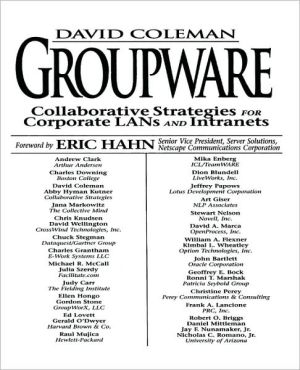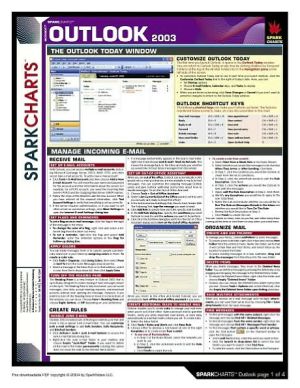Groupware: Collaborative Strategies for Corporate LANs and Intranets
72772-7\ The all-new decision-maker's guide to intranets and groupware.\ With today's new intranet and groupware technologies, you can dramatically improve collaboration and teamwork throughout your enterprise—and beyond. This book is a complete decision-maker's guide to leveraging those technologies. It will help you:\ \ Compare intranet and traditional groupware solutions.\ Understand powerful new hybrid solutions that combine groupware security with the Web's extraordinary flexibility.\...
Search in google:
This book helps MIS professionals make critical groupware decisions, and offers essential, up-to-date guidance on intranets.This book presents the most up-to-date, thorough review of the groupware marketplace available, with special focus on the dramatic growth of intranets. It covers hot groupware topics such as desktop videoconferencing, e-mail and messaging technologies, and new Web-base meeting software. It also includes sections on implementing groupware in vertical markets, ranging from the construction industry, to consulting firms, to hardware and software development teams. The book also includes a comprehensive list of groupware resources, including Web sites and URLs; groupware interest groups; lists of vendors and products, events, newsletters, conferences and more.The book is ideal for MIS professionals and managers involved in selecting, implementing, or managing groupware.
Preface\ Groupware: Technology and Applications was released only 15 months ago. That book covered the groupware industry, before Lotus was bought by IBM, before Collabra was bought by Netscape and before the word intranet was part of the common vernacular. In fact, the book was almost obsolete as soon as it was released. In part, that is characteristic of paper publishing, however, it is also due to the increasingly frantic pace of technologic change in our world. In order to release information in a more timely manner, I often publish the results of my work as a Hot Tip of the Month on my firm's web page at www.collaborate.com. Even so, traditional book publishing gives us the opportunity to collect the thoughts of industry leaders and quantify them in a form that is not dependent on being connected to a computer. Therefore, when Prentice Hall suggested an update to Groupware: Technology and Applications, the opportunity to report on the changes in collaborative products and technologies was not to be missed.\ There are two other reasons why a new edition is valuable at this time. First, the increased velocity of change presents new challenges to organizations, and there are no established procedures for dealing with these changes. Change comes so fast and so often that when technology is introduced and updated, people hardly have a chance to get used to one new way of working before they are confronted with another new way to work. One of the side effects of working in this dynamic environment is that people have increased their resistance to these changes, effectively undermining the project. Almost every chapter in this book addresses the issue of change management in one form or another. Our goal was to provide business readers with the benefit of other's experiences, in a risk-free manner.\ The second reason for a new book is the new reality of doing business on the Internet and intranets. When the first book was written, the Internet was just emerging as being a curiosity for hackers and geeks. Some companies had posted web pages as marketing tools, but most of those companies were hi-tech organizations. The Internet had still not hit the mainstream. Today, having Web presence is essential to doing business and almost all major corporations have well developed web sites. Additionally, intranets have become the infrastructure of choice for intra-enterprise collaboration. Groupware, which was initially LAN-based, has rapidly moved its functionality onto these IP networks. The result is that technologies that were counter-intuitive, expensive, and difficult to learn, administer, and maintain, have now become more visual, easier to use and very inexpensive. Consequently, groupware on the Internet and intranets has become one of the hottest trends in computing today.\ The first section of this book provides an introduction to groupware and some of the major issues businesses face when adopting collaborative technologies, either on a LAN or Web-based infrastructure. Additionally, a full chapter is devoted to the results of research performed by Collaborative Strategies. In this study, we spoke with CIOs and other MIS executives about how they are currently using the Internet and intranets to support electronic collaboration, and how they want to in the future.\ The second section focuses on specific collaborative technologies, such as e-mail, workflow, group calendaring and scheduling, electronic meeting systems, and video conferencing. These chapters provide significant detail about how the products were developed, what business issues they address, and where they are going in the future.\ The third section contains chapters contributed by major groupware vendors who discuss their design philosophy, current product offerings, and their plans for the future. Vendors discuss both their web-based functionality as well as their tried and true LAN-based functionality.\ The fourth section focuses on user case studies and user stories. Many of these case studies are about Notes, because Notes is the most mature collaborative product in the market. However, the purpose of this section is to show how many different collaborative technologies are used. Also, many of the ideas about the organizational aspects of groupware which I introduce in the opening chapter are explored more fully in these case studies.\ Finally, the fifth section provides a comprehensive reference source for information on groupware, collaboration, organizational development, management consulting, intellectual property, re-engineering, BPR, workflow and many other things.\ The primary goal of this book is to provide timely information on all aspects of electronic collaboration. The trend toward distributed workforces, project teams, and collaborative strategies will increase well into the next century. We find collaboration is different in each culture, each corporate culture, and with each technology. This makes for a very interesting mix, an interesting field of study, and a formidable challenge to the vendors in this area.\ Questions, comments and feedback on this volume are welcome, via e-mail, at davidc@collaborate.com
ForewordPrefaceAcknowledgments1Groupware - The Changing Environment12Collaborating on the Internet and Intranets393The Evolution of Web-Based Conferencing and Workflow554Electronic Mail and Messaging855Calendaring and Scheduling: Managing the Enterprise's Most Valuable, Non-Renewable Resource - Time1156Workflow: Applying Automation to Group Processes1437AElectronic Meetings as Today's Presentations1837BWhen You Really Must Have Them: Face-to-Face Meetings Using Keypad Electronic Meeting Systems1937CHow To Facilitate Distributed Meetings Using EMS Tools2077DThe Virtual Office Work-Space: GroupSystems Web and Case Studies2317EUsing Meetingware and Facilitators: Guidelines and Case Studies2558Collaborative Presentation Technologies: Meetings, Presentations, and Collaboration2699Desktop Videoconferencing32110Deploying Second-Generation Intranets with Lotus Notes34711Novell and the Groupware Market37312TeamWARE: Managing the Transition to Intranet-based Groupware and Messaging40713Increasing Business Performance with Internet Collaboration Services: HP's Communication & Collaboration Strategy42714The Divergence of Two Worlds: Oracle's InterOffice45715Designing Groupware: A Management Primer50116Groupware at Big Six Consulting Firms: How Successful Was It?53317Groupware & Reengineering: The Human Side of Change56518Applying Groupware to the Architectural Design and Construction Industry: PRC's Genesis Strategy59919Groupware in Hardware and Software Development Environments62920Groupware, Knowledge Creation and Competitive Advantage647Collaborative Resources679Index689








